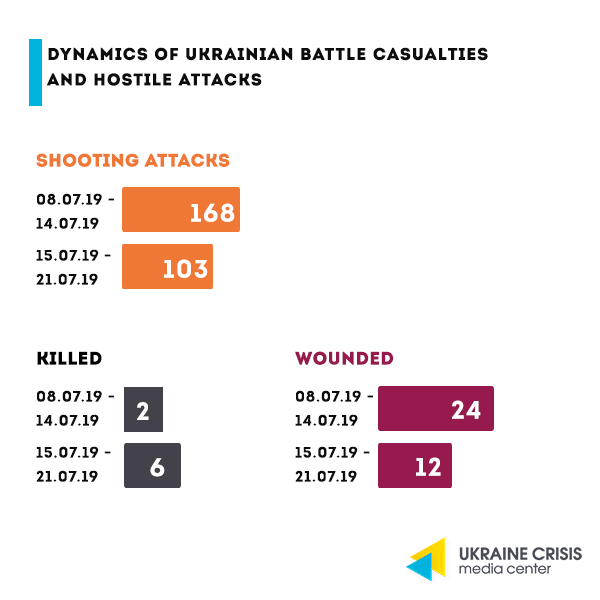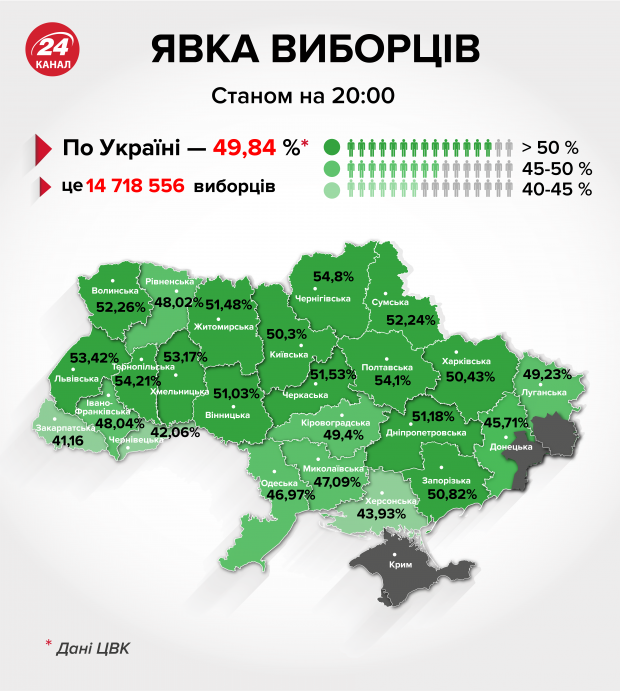Situation in the combat zone

A new ceasefire effective July 21. On July 17 in Minsk the Trilateral Contact Group agreed a cease fire effective July 21. They also agreed to grant OSCE access to the territories in Donetsk and Luhansk regions not controlled by the Ukrainian government.
Last week Russia-backed militants were violating the ceasefire using Minsk-proscribed 82-mm mortars. They also fired upon the Ukrainian troops from grenade launchers, infantry fighting vehicles, heavy machine guns and small arms.
Joint Forces Operation reported that on July 21 Russian proxies violated the ceasefire once. Ukrainian troops’ positions in the area of responsibility of “Pivnich” (North) operational-tactic command came under fire near Khutir Vilnyi. The hostile fire came from infantry fighting vehicles and heavy machine guns.
Two killed by explosive device. Two Ukrainian servicemen were killed and two got injured by an explosive device planted by a hostile subversive-reconnaissance group.
OSCE: the “harvest ceasefire” violated 75 times. From 00:01 to 16:00 on 21 July when the “harvest ceasefire” was already announced, the OSCE Special Monitoring Mission recorded 75 ceasefire violations.
Parliamentary elections in Ukraine: five conclusions

Main results: low voter turnout, historic victory of the President’s party
Based on information collected from all the 199 constituencies, the voter turnout at the early parliamentary elections in Ukraine was 49,84 per cent. The reasons for a relatively low voter turnout are the holiday season and a smaller public interest in parliamentary elections compared to the presidential run.
The results based on 75,22 % processed protocols of election commissions show that five parties make it into Verkhovna Rada (the Parliament): “Servant of People” (Sluha narodu) – 42,76 per cent; “Opposition Platform – For Life” (Opozytsiyna platforma – Za zhyttia) – 13 per cent; “European Solidarity” (Yevropeiska solidarnist) – 8,07 per cent, “Batkivshyna” (Fatherland) – 8,07 per cent and “Holos” (Voice) – 6,14 per cent.
“Servant of People” also took the lead in 106 out of the total 223 majoritarian (multi-member) constituencies.
“Servant of People” will have 247 parliamentary seats, “Opposition Platform – For Life” – 43, “European Solidarity” – 27, “Batkivshyna” – 25, “Holos” – 20, other parties get nine seats, 50 independent candidates will also become parliamentarians.
Single-party majority in the Parliament?

As the “Servant of People” can take about 250 seats in the Parliament, it will allow the party to form the majority without creating a coalition with other political forces. At the same time the party will not have the constitutional majority – 300 votes, and will need votes by other political forces when adopting eventual amendments to the Constitution.
These are historic results: it is the first time in Ukraine’s modern-day history as an independent state that a party gets single-party majority in the Parliament. It also means that the new President and his party get exclusive responsibility over developments in the country. There are political risks of having the power usurped but there is also a possibility to quickly implement the reforms vowed by the political force.
At a press briefing on Monday, July 22, head of the “Servant of People” party Dmytro Razumkov said that it is quite possible that the political force may not need to ally with other parties. “In Rada we will be able to cooperate with all political forces that share the same ideology as ours, the same basic vision of our country’s development,” Razumkov said.
Who will form the government?
With the majority in the Parliament, the “Servant of People” party will be able to form the government unilaterally. Speaking at the press conference on July 22 the chief of party Razumkov mentioned that the “Servant of People” team has their candidates to the post of the Prime Minister. Answering the question if “Servant of People” would agree to support Sviatoslav Vakarchuk to the post of the Prime Minister, Razumkov said that the head of the government will be suggested by the coalition the composition of which is yet unknown.
“Let’s take a look at the results of ‘Holos’ and of ‘Servant of People’. I think we have enough people in our team who can respond to the challenges in the country. We have two-three candidates for each post,” the politician said.
Who will be in the opposition?
It is possible that the opposition in the Parliament of the ninth convocation will be diverse and multi-vector by orientation. On the one hand there is pro-Russian force “Opposition Platform – For Life”, on the other – pro-European forces including Petro Poroshenko’s “European Solidarity” and, possibly, “Batkivshyna” and “Holos”. It may well be expected that “Holos” and “Batkivshyna” will have possibilities for ad-hoc cooperation or joint voting with “Servant of People” while “European Solidarity” will stay in the opposition. The situation of having two diverse opposition forces in the Parliament is also unprecedented.
When will new authorities start?
When will the official results be released? Within 15 days the Central Election Commission will process all 100 per cent of votes casted both through party lists and in majoritarian constituencies.
The vote count will have been finalized by August 5. Final election results will be announced then.
The Central Election Commission will then have five more days – until August 10 at the latest, to officially release the election results by publishing them in official governmental newspapers “Governmental Courier” (Uryadovyi kuryer”) and “The Voice of Ukraine” (Holos Ukrainy). Full list of all elected MPs is supposed to be released there in alphabetical order.
When will the first sitting of the new Rada happen? The first sitting of the Verkhovna Rada needs to take place 30 days after the official results are released – not later than September 9, 2019.
At the latest on September 9 the MPs will be able to make their first decisions and adopt their resolutions as well as start negotiating on forming the coalition.
When will the coalition be formed if at all? According to the Constitution it is the coalition that forms the government. The MPs have one month to negotiate the coalition starting from the day when the first Rada sitting takes place and when the oath is taken. The coalition is supposed to have been formed by October 9, 2019 at the latest.
Does “Servant of People” even need the coalition? The Article 83 of the Constitution equalizes the rights of the faction holding the majority of seats from the constitutional composition of the Rada with those of the coalition: “The parliamentary faction in the Verkhovna Rada of Ukraine comprising the majority of MPs in the constitutional composition of the Verkhovna Rada, enjoys the rights of the coalition of parliamentary factions in the Verkhovna Rada stipulated by this Constitution.” So the coalition may not be required at all.
When will the new government take office? According to the Constitution the coalition (or the faction that holds the majority) has to suggest to the President their candidate to the Prime Minister’s post. The coalition also suggests the candidates to ministers’ posts except for the Defense and Foreign Affairs Ministers appointed by the President.
The President has to introduce to the Parliament a candidate to the Prime Minister’s post (previously listed by the coalition), as well as candidates to the posts of the Foreign Affairs and Defense Ministers. The newly appointed Prime Minister then suggests rest of the ministers for parliamentary approval.
At the latest Rada will start working in September, the government will take office in October. At the same time President Zelenskyi and representatives of his political force “Servant of People” stated that they plan holding the first parliamentary sitting already on Ukraine’s Independence Day on August 24.





